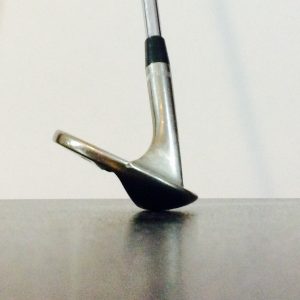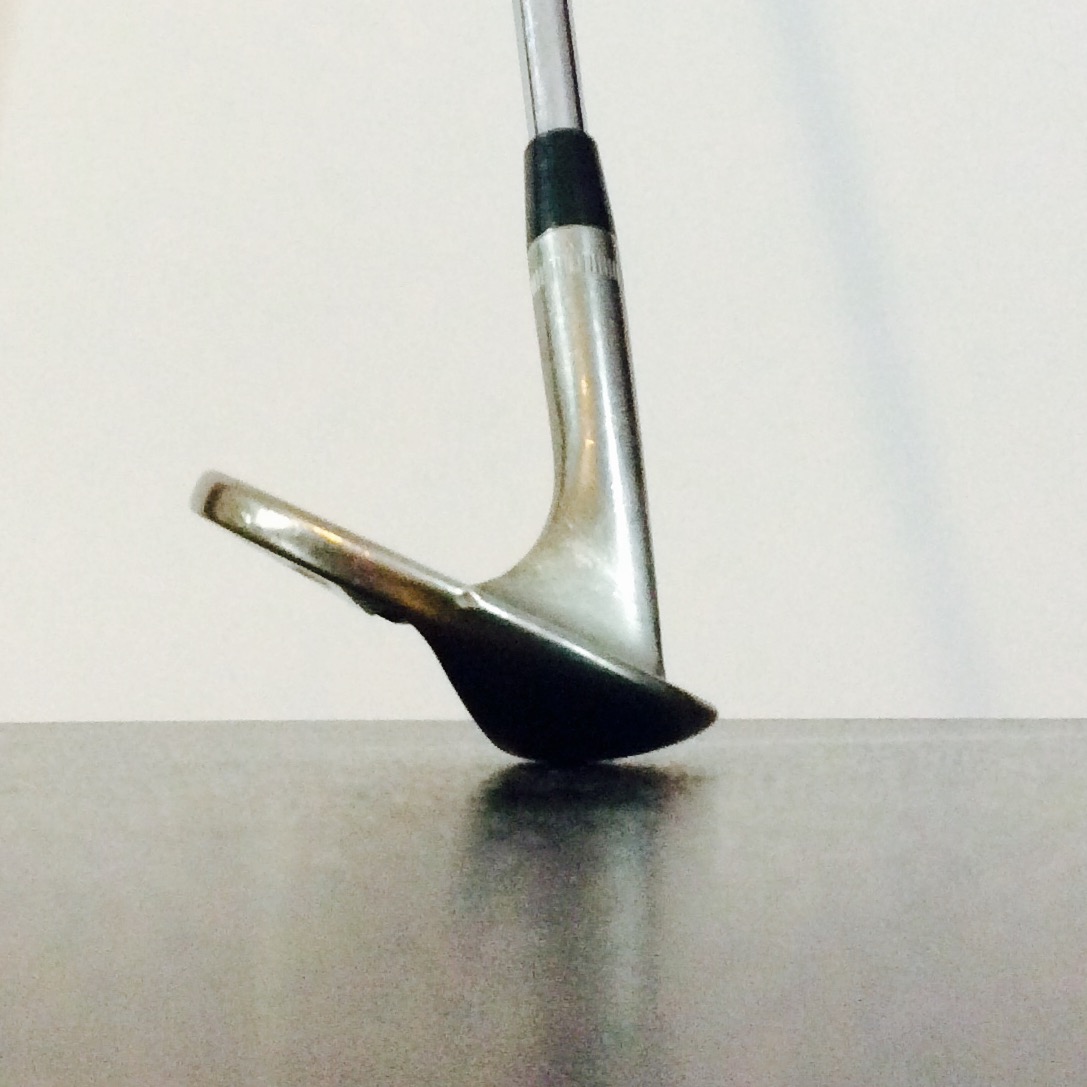Making improvements in golf becomes more challenging as you become a more accomplished player. However, some advantages can be gained with some of the correct equipment, although there is a lot of misleading information.
Here is some helpful information on the bounce on golf wedges. Golf Wedge Bounce, Explained.
What is the Golf Wedge Bounce?
Your golf wedges and putter will be your scoring clubs, especially when you become a more consistent ball striker, so it is vital to have a good understanding of bounce of wedges.
The Bounce on a golf wedge is simply the angle formed between the leading edge and the exact position the sole of the wedge meets the ground. Each manufacturer will design wedges targeted at different surfaces and each golfer’s techniques.
The Golf Wedge Bounce is basically the part of the golf club that hits the ground at impact. A golf wedge does not sit flat on the ground, as per the below photo. Notice the angle formed between the leading edge and the sole? This is known as the golf wedge bounce angle.

The bounce angle is measured in degrees and can vary from one wedge to another. Wedges with higher bounce angles have a more pronounced angle between the leading edge and the sole, while wedges with lower bounce angles have a smaller angle. Bounce angles typically range from 4 degrees to 14 degrees, although some specialty wedges may have higher or lower bounce angles.
What is the Purpose of the Bounce on a Golf Wedge?
The purpose of the bounce is to prevent the club from digging too deeply into the ground or sand, especially on shots where the club strikes the ground before the ball. When the bounce interacts with the turf or sand, it helps the club glide through the surface, preventing excessive digging and reducing the chance of the club getting stuck.
Surfaces and Playing Conditions
As a general rule of thumb, golfers that are playing firmer conditions should choose a lower golf wedge bounce, and golfers playing softer conditions should consider a wedge with more bounce.
That’s all well and good, but what if I play a variety of golf courses with different conditions? This is where a mid-bounce wedge can help a golfer accommodate most playing conditions.
A higher sand wedge bounce might be a good option if you are playing a course with very soft bunkers. However, the opposite is true if you are playing a course with harder bunkers.
Different bounce angles are suited for other playing conditions and player preferences. For example, higher bounce wedges are generally better for soft turf or fluffy sand, as they prevent the club from digging in too much. They are also useful for players with steeper swing angles or who tend to hit the ground before the ball. Lower bounce wedges, on the other hand, are more suitable for firm turf or tight lies, as they allow the club to cut through the surface with less resistance.
Does Technique have an impact on the Wedge Bounce?
A lot of golfers have different techniques for chipping, pitching, and bunker shots.
If you have a steep angle of attack and cut across the ball, then a golf wedge with more wedge bounce would be ideal so it doesn’t dig into the ground so much.
If you have a relatively shallow angle of attack and don’t take divots, then a wedge with less bounce would be ideal.
The angle of attack refers to the angle at which the clubhead strikes the ball and the turf or sand. Golfers with a steeper angle of attack tend to benefit from higher bounce wedges as they help prevent the club from digging too deeply into the ground. Conversely, golfers with a shallow angle of attack may find lower bounce wedges more suitable, as they allow for cleaner contact with the ball and turf.
The divot pattern left behind after hitting a shot can indicate how the wedge interacts with the turf. For example, golfers who take shallow divots or have a sweeping swing tend to do well with lower-bounce wedges. In contrast, golfers who take deeper divots or have a more aggressive downward strike may find higher bounce wedges more effective in preventing excessive digging.
Golf Wedge Grinds
Companies have introduced various grinds to narrow the gap in different golf course conditions. This is the additional shaping of the sole of the wedge.
The sole plates of some of the wedges have been crafted to accommodate players that like to open or keep the face square whilst playing shots around the green.
Most golf manufacturers have produced a sole grind designed for opening the face, keeping it square, harder or softer surfaces, and bunker shots. A wedge designed for mainly bunker shots generally has a wider soleplate and more golf wedge bounce loft.
Conclusion
There are a couple of things to consider when choosing the correct bounce on a golf wedge. The type of playing conditions and your technique usually are pretty good indicators as to how much bounce you will need.
A club with more bounce is generally easier to use for most golfers because many of us have a steeper angle of attack.
If you are undecided which bounce option you should choose then a mid-bounce wedge would be ideal, as it generally covers most playing conditions. It might also pay to have a look at a wedge bounce guide.
Choosing the right bounce angle for your wedges depends on various factors such as the type of courses you play, the playing conditions, your swing style, and personal preference. It’s often recommended to try out different bounce angles to see which one works best for your game. Consulting with a professional club fitter or golf instructor can also provide valuable guidance in determining the appropriate bounce angle for your wedges.
For some tips on a shot in which you need a sand wedge, check out the link on How to Play a Bunker Shot.
The Golf wedges also come in handy for the chip shot. Have a look at the post on How to Chip a Golf Ball and get on the right track.
Callaway Golf is one of the leaders in Golf Wedge Technology, have a look out the post on some of the Callaway Mack Daddy Wedges.
If you have any questions, please leave them below.


Nice article on golf wedges. Lots of information but was wondering because I play in Scotland on mostly soft ground as it rains all the time would a mid bounce be the best to choose or a high bounce as its soft conditions most of the time and the fact that am not that good at golf.
Hi Andy
I appreciate your comments.
A higher bounce wedge is always better in the softer conditions. If you also tend to have a steeper angle of attack and take a larger divot, then a higher bounce wedge should be considered. This will help slide under the turf or sand a lot easier and not dig.
Good luck with your golf.
Cheers
Chris
I stumbled across your site looking for a golf club for a friend who is a huge golfer. I on the other hand am not. I had no idea there were different wedges for different conditions. I know he golfs in a dessert type area with very little rain other than the irrigation system. I am assuming the the wedge with more bounce is the best? Thanks for this informative article.
Hi Jim
I appreciate your comments.
It can depend on both conditions and technique. A player that cuts a cross the ball and takes big divots will benefit from a wedge with more bounce as it doesn’t dig into the ground and just bounces off the surface. Players with a shallow angle of a approach that don’t take divots would benefit from a wedge with less bounce. These are just general rules as both hard and soft surfaces should also come into consideration when choosing a wedge.
A mid bounce wedge will cover most conditions if golfers are playing a lot of different golf courses.
Cheers
Chris